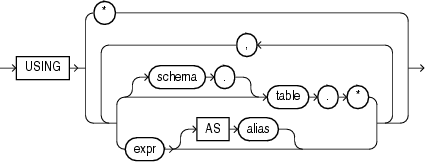42.17 PREDICTION_SET
Syntax
prediction_set::=
Analytic Syntax
prediction_set_analytic::=
cost_matrix_clause::=
mining_attribute_clause::=
mining_analytic_clause::-
See Also:
"Analytic Functions" for information on the syntax, semantics, and restrictions of mining_analytic_clause
Purpose
PREDICTION_SET returns a set of predictions with either probabilities or costs for each row in the selection. The return value is a varray of objects with field names PREDICTION_ID and PROBABILITY or COST. The prediction identifier is an Oracle NUMBER; the probability and cost fields are BINARY_DOUBLE.
PREDICTION_SET can perform classification or anomaly detection. For classification, the return value refers to a predicted target class. For anomaly detection, the return value refers to a classification of 1 (for typical rows) or 0 (for anomalous rows).
bestN and cutoff
You can specify bestN and cutoff to limit the number of predictions returned by the function. By default, both bestN and cutoff are null and all predictions are returned.
-
bestNis theNpredictions that are either the most probable or the least costly. If multiple predictions share theNth probability or cost, then the function chooses one of them. -
cutoffis a value threshold. Only predictions with probability greater than or equal tocutoff, or with cost less than or equal tocutoff, are returned. To filter bycutoffonly, specifyNULLforbestN. If the function uses acost_matrix_clausewithCOST MODEL AUTO, thencutoffis ignored.
You can specify bestN with cutoff to return up to the N most probable predictions that are greater than or equal to cutoff. If costs are used, specify bestN with cutoff to return up to the N least costly predictions that are less than or equal to cutoff.
cost_matrix_clause
You can specify cost_matrix_clause as a biasing factor for minimizing the most harmful kinds of misclassifications. cost_matrix_clause behaves as described for "PREDICTION_COST".
Syntax Choice
PREDICTION_SET can score the data by applying a mining model object to the data, or it can dynamically mine the data by executing an analytic clause that builds and applies one or more transient mining models. Choose Syntax or Analytic Syntax:
-
Syntax: Use the
prediction_setsyntax to score the data with a pre-defined model. Supply the name of a model that performs classification or anomaly detection.Use the
prediction_set_orderedsyntax for a model that requires ordered data, such as an MSET-SPRT model. Theprediction_set_orderedsyntax requires anorder_by_clauseclause.Restrictions on the
prediction_set_orderedsyntax are that you cannot use it in theWHEREclause of a query. Also, you cannot use aquery_partition_clauseor awindowing_clausewith theprediction_set_orderedsyntax.For details about the
order_by_clause, see "Analytic Functions" in Oracle Database SQL Language Reference. -
Analytic Syntax: Use the analytic syntax to score the data without a pre-defined model. The analytic syntax uses
mining_analytic_clause, which specifies if the data should be partitioned for multiple model builds. Themining_analytic_clausesupports aquery_partition_clauseand anorder_by_clause. (See "analytic_clause::=".)-
For classification, specify
FORexpr, whereexpris an expression that identifies a target column that has a character data type. -
For anomaly detection, specify the keywords
OF ANOMALY.
-
The syntax of the PREDICTION_SET function can use an optional GROUPING hint when scoring a partitioned model. See GROUPING Hint.
mining_attribute_clause
mining_attribute_clause identifies the column attributes to use as predictors for scoring. When the function is invoked with the analytic syntax, these predictors are also used for building the transient models. The mining_attribute_clause behaves as described for the PREDICTION function. (See "mining_attribute_clause".)
See Also:
-
Oracle Machine Learning for SQL User’s Guide for information about scoring.
-
Oracle Machine Learning for SQL Concepts for information about predictive Oracle Machine Learning for SQL.
Note:
The following example is excerpted from the Oracle Machine Learning for SQL examples. For more information about the examples, see Appendix A in Oracle Machine Learning for SQL User’s Guide.
Example
This example lists the probability and cost that customers with ID less than 100006 will use an affinity card. This example has a binary target, but such a query is also useful for multiclass classification such as low, medium, and high.
SELECT T.cust_id, S.prediction, S.probability, S.cost
FROM (SELECT cust_id,
PREDICTION_SET(dt_sh_clas_sample COST MODEL USING *) pset
FROM mining_data_apply_v
WHERE cust_id < 100006) T,
TABLE(T.pset) S
ORDER BY cust_id, S.prediction;
CUST_ID PREDICTION PROBABILITY COST
---------- ---------- ------------ ------------
100001 0 .966183575 .270531401
100001 1 .033816425 .966183575
100002 0 .740384615 2.076923077
100002 1 .259615385 .740384615
100003 0 .909090909 .727272727
100003 1 .090909091 .909090909
100004 0 .909090909 .727272727
100004 1 .090909091 .909090909
100005 0 .272357724 5.821138211
100005 1 .727642276 .272357724





